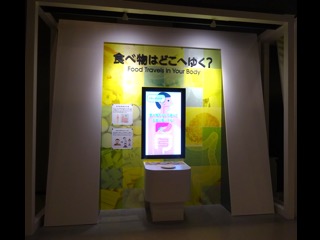Nagoya City Science Museum
TOP > Exhibition Guide > Floor Map> Food Travels in Your Body
Food Travels in Your Body



Purpose of Exhibition
This is an exploratory exhibit that starts when a picture of food on a disk is placed on a dish, and uses animation to show the digestion of food, the absorption of nutrients, and the discharge of unnecessary substances.
Food illustrated on the disks is separated into 3 categories.
- Proteins (meat, fish, eggs, beans, etc.)
- Carbohydrates (rice, bread, noodles, etc.)
- Fats (butter, oil, etc.)
Additional Knowledge
Food is digested and absorbed differently according to the category. Please pay attention to the shape and size of the molecules in the animation.
The stomach is nearly "J"-shaped (although the shape varies somewhat from person to person) and has its inlet called "cardia" and outlet called "pylorus", which are functionally closed so that the food does not leak out of the stomach. The food gradually goes down to the intestines from here.
In the small intestine, protein, starch and undecomposed fat are first broken down and then digested. The small intestine absorbs nutrients from the digestion and releases them into the capillaries in the surrounding area. The large intestine, which is located, forming a nearly "Q"-shaped loop, in the abdomen, absorbs water.
Protein: A molecule composed of a long chain of about 20 different amino acids.
- Mouth to esophagus: The food is broken down into smaller pieces, but the size of the protein molecule remains unchanged.
- Stomach: Long protein molecules are digested and become shorter.
- Small intestine: Mixed with digestive juice from the pancreas, the molecules become shorter and are absorbed into the blood vessel from the intestinal wall.
Carbohydrates: Please pay attention to the number of hexagons representing glucose.
- Mouth to esophagus: The food is broken down into smaller pieces, and starch molecules (a structure in which many hexagons are linked in a chain) are digested, resulting in two hexagonal maltose and several hexagonal molecules.
- Stomach: The molecules are mixed but are not broken down.
- Small intestine: Mixed with digestive juice from the pancreas, the molecules becomes shorter and are absorbed into the blood vessel from the intestinal wall, and head to the liver.
- Liver: Glucose is stored as glycogen with many glucose connected, and is converted to glucose after separating from the glycogen when it is needed.Glucose is transported to muscles and the brain where it is used as a source of energy.
Fat: A molecule comprised of three long fatty acids linked to glycerol.
- Mouth to esophagus: The food is broken down into smaller pieces, but the size of the fat molecule remains unchanged.
- Stomach: The molecule is mixed with digestive juices, but not broken down.
- The gall bladder secretes digestive juice (bile) to make the fat easy to mix with water (emulsification).
- Small intestine: Mixed with digestive juice from the pancreas, the molecule is decomposed into monoglycerides, and enter lymphatic vessels (instead of blood vessels) from the wall of the small intestine (it is still a fat molecule at this time).
[Are feces just left over food?]
Feces contain food residue, but also nearly the same percentage of dead intestinal bacteria and sloughed off intestinal cells. The largest component of feces, about 80%, is water.
[Where does everything go from inside the stomach?]
Nutrients absorbed from the small intestine can be converted into other forms in the liver, and transported to blood vessels and sent to the entire body. Here, it is used to create power and energy that build up your body and keep it in good condition.
[Does it quickly become urine once absorbed?]
Absorbed nutrients flowing in the blood are not released as urine in a mechanism that prevents protein and fat in the blood flowing into the kidneys from being released in primary urine (the source of urine), and reabsorbs glucose after being released into to the primary urine. What are discharged as urine are the converted elements that the body does not need.
Article and illustrations by Tomoko Horiuchi, curator
